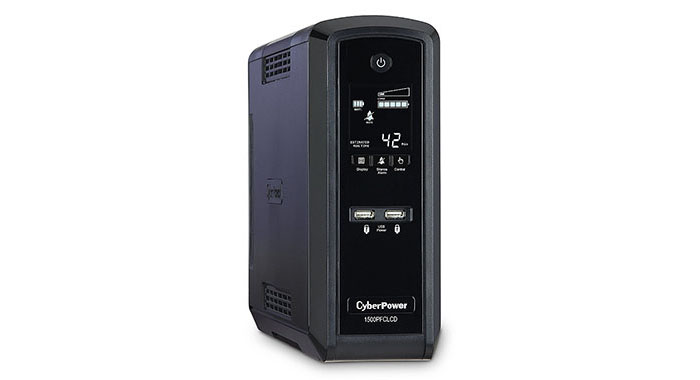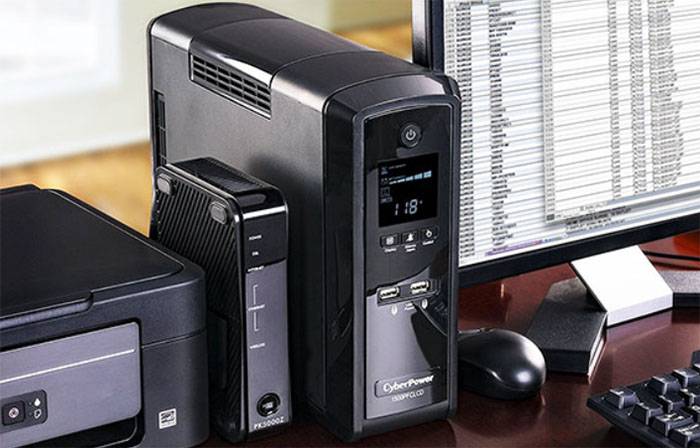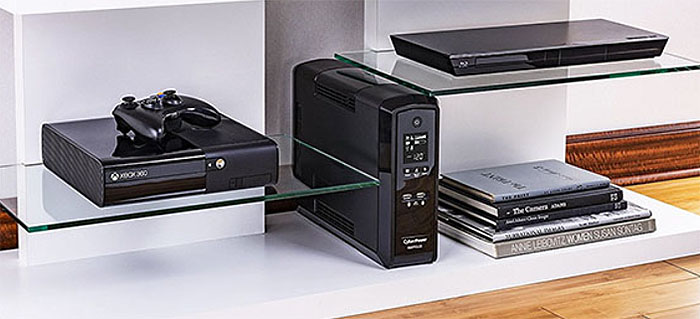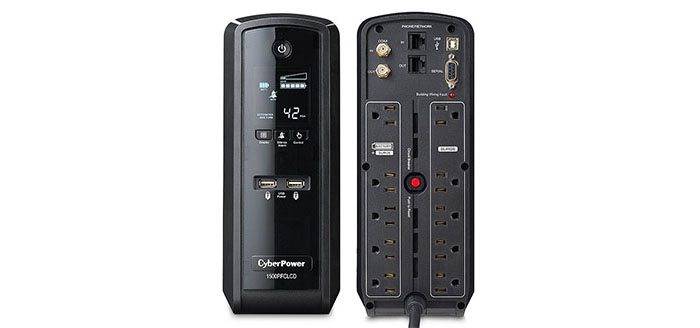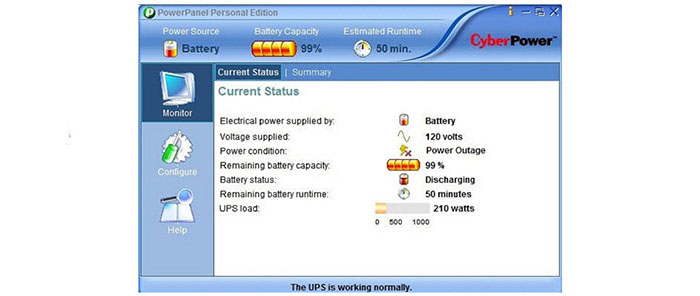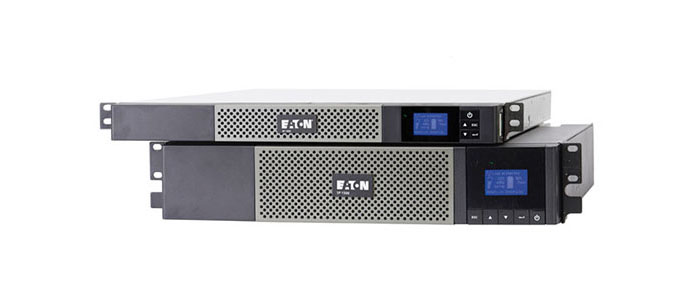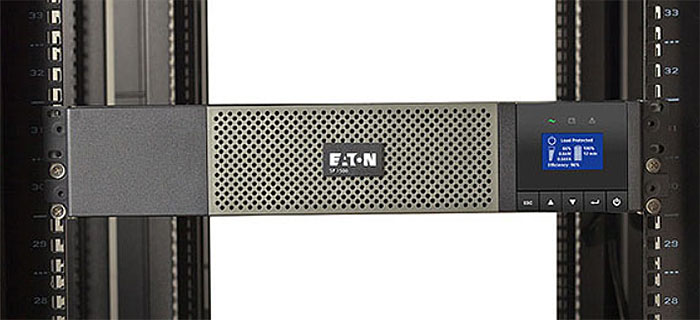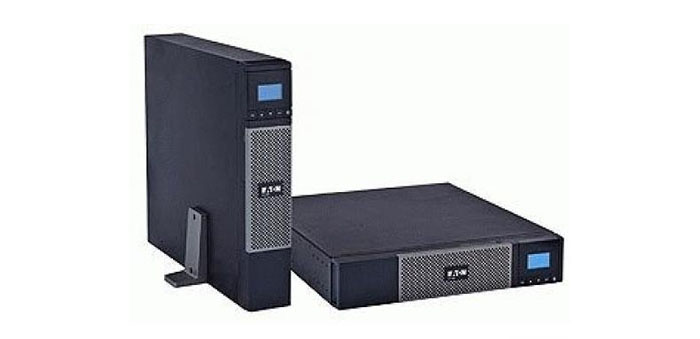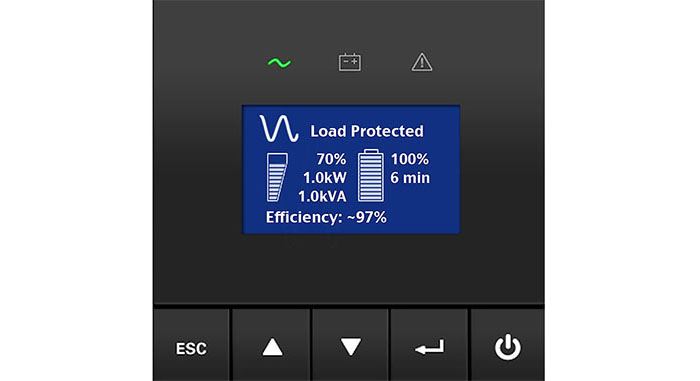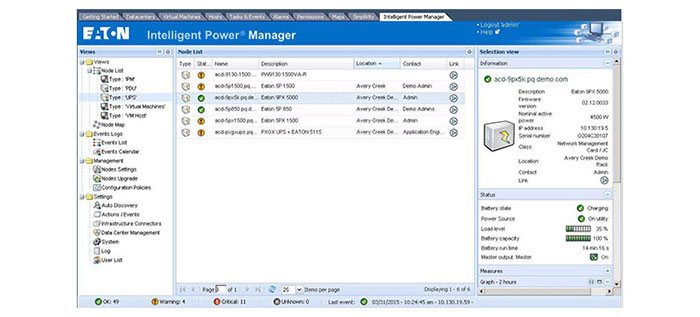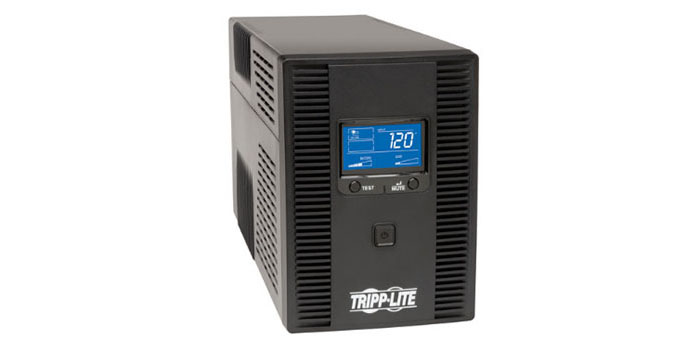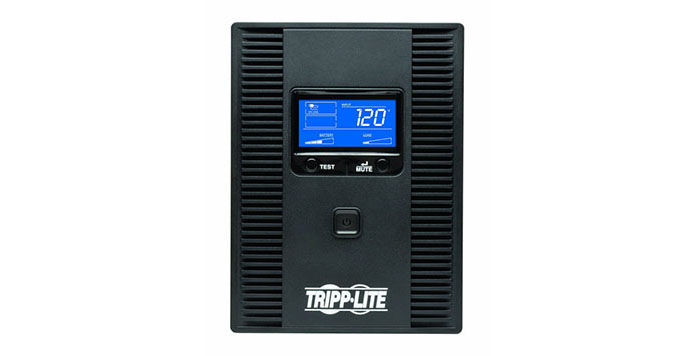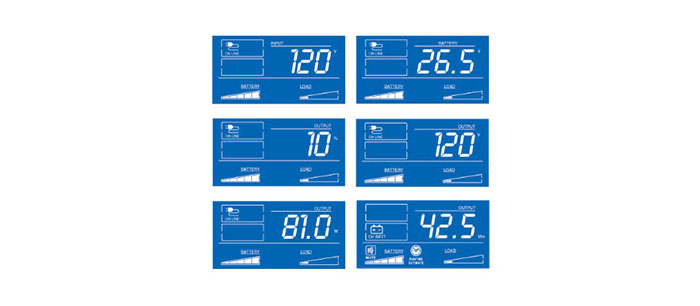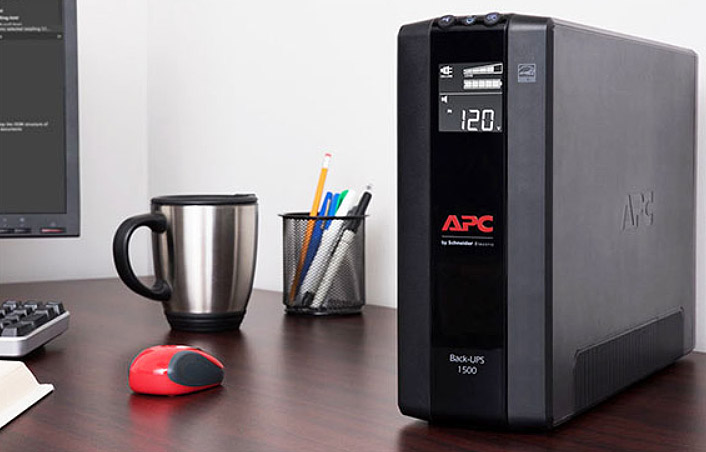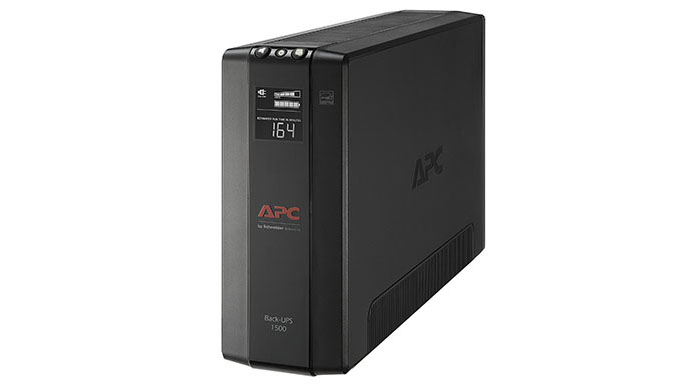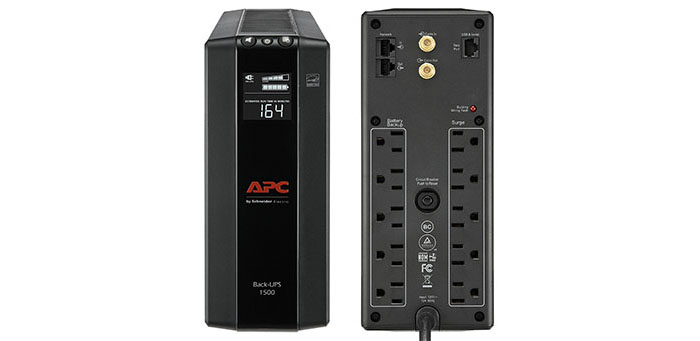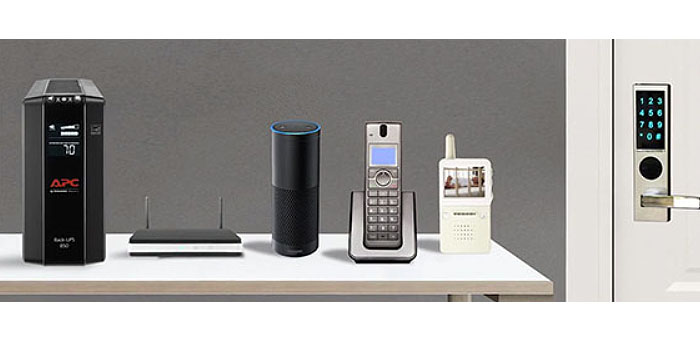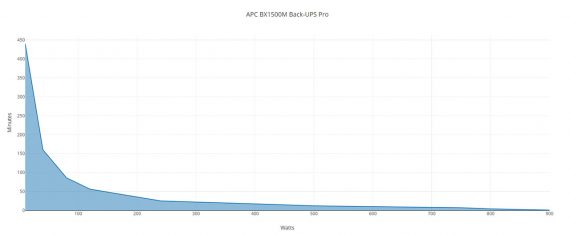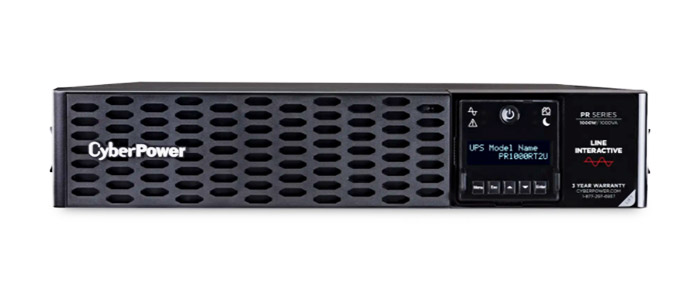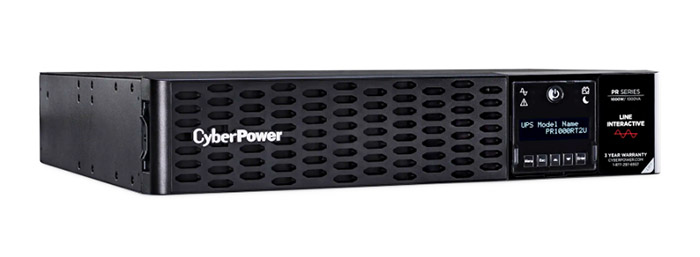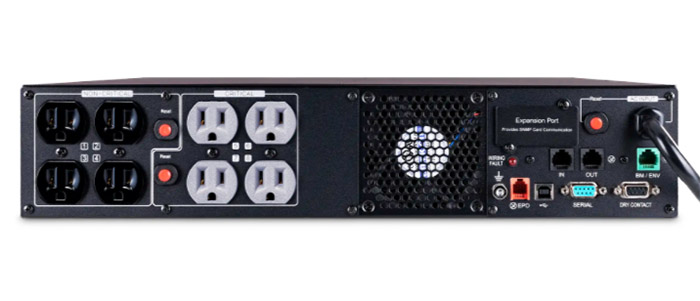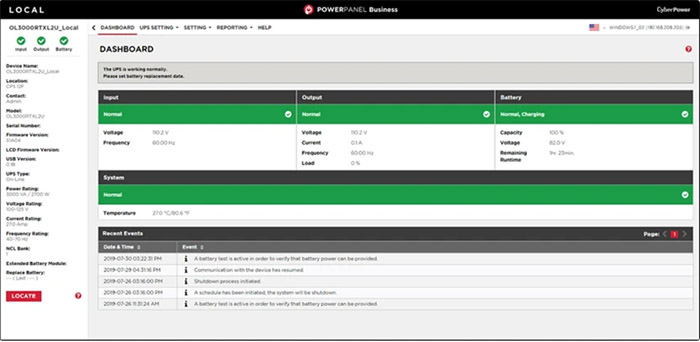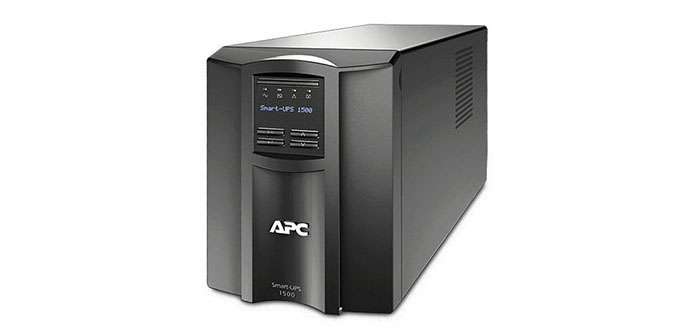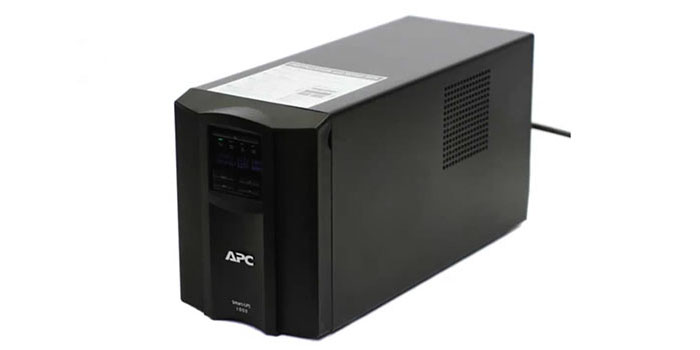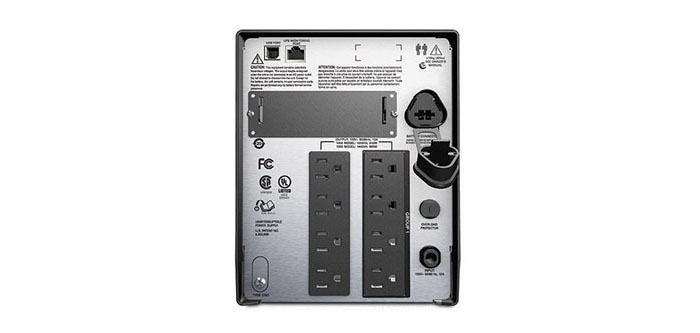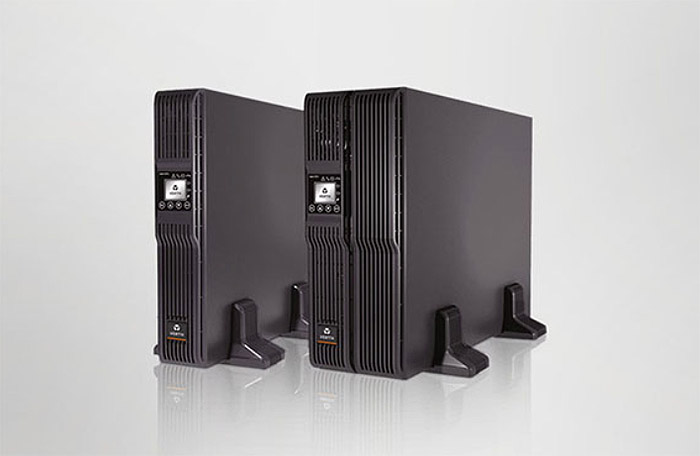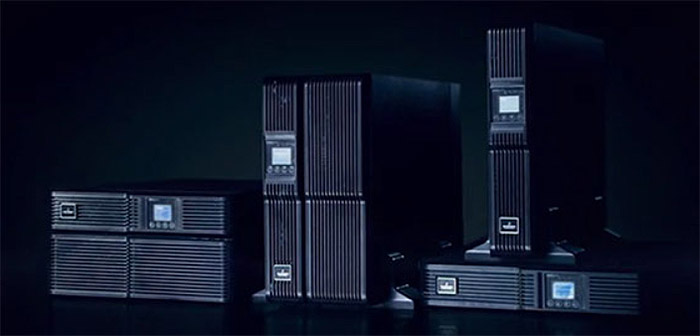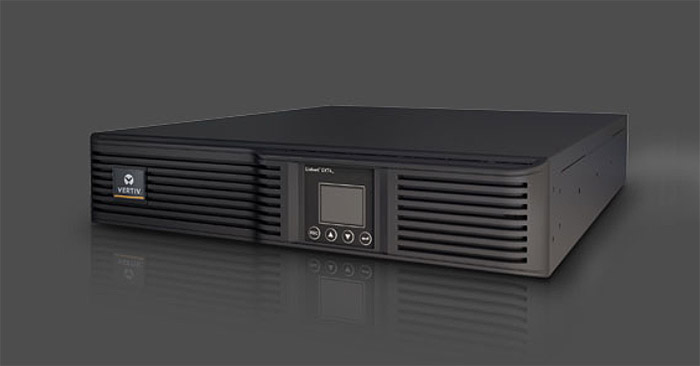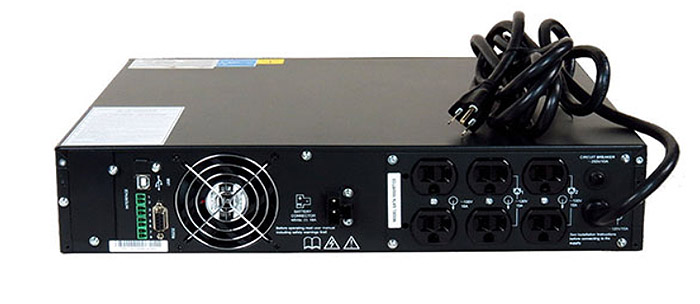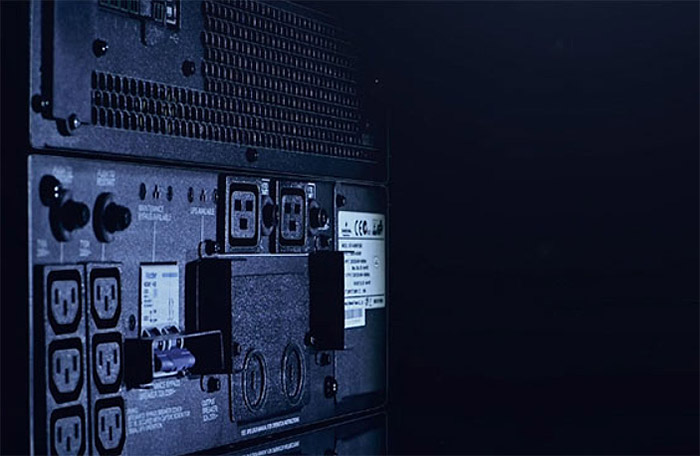The uninterruptible power supplies come in various shapes and sizes, but the main differentiating factor remains the topology. Based on the technology that’s used, we have offline UPS devices (also known as standby uninterruptible power supplies), line-interactive UPS devices (the more commonly used type of UPS in households and smaller offices, since these are more reasonably priced) and lastly, the online (double-conversion) uninterruptible power supplies which work very well with sensitive electronic equipment – usually found in the medical industry, laboratories.
Most electronic devices should work fine with an UPS that has a simulated sine wave output, but, the more sensitive equipment may not play nice with anything less than a clean, close-to-ideal sine wave UPS (a common scenario for some sensitive audio devices or medical equipment – Active PFC power supplies can work with a good line-interactive UPS).
If you’re unsure about what UPS should you purchase in order to have your devices safe and protected, I have compiled a list of the best uninterruptible power supplies (UPS) to help you make the best decision (mainly addressing the line-interactive UPS).
| CyberPower CP1500PFCLCD | Eaton Electrical 5P750RC | Tripp Lite SMART1500LCDT | APC BX1500M Back-UPS Pro |
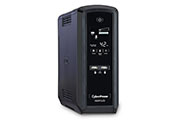 |
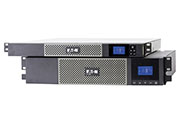 |
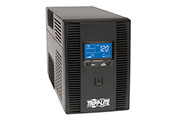 |
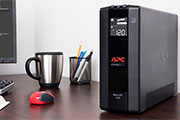 |
| Read More | Read More | Read More | Read More |
| Cyberpower PR1000RT2U | APC Smart-UPS SMT1500 | Eaton Ellipse Pro UPS | Liebert GXT4-1000RT120 |
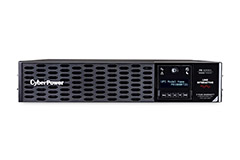 |
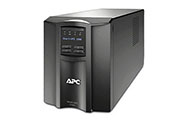 |
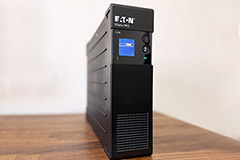 |
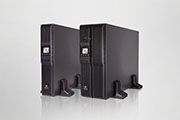 |
| Read More | Read More | Read More | Read More |
 |
An uninterruptible power supply is an electric device that provides emergency power to the connected equipment in case the primary power source fails. In most cases, an UPS incorporates a battery, a surge protector and a power supply in one unit, but most uninterruptible power supplies also have additional filters (RFI/EMI noise filtering and Automatic Voltage Regulation or AVR) that protect your equipment in case of brownouts, without relying on the battery power.
Best 4 UPS (uninterruptible power supplies) brief comparison
| CyberPower CP1500PFCLCD | Eaton Electrical 5P750RC | Tripp Lite SMART1500LCDT | APC BX1500M Back-UPS Pro | |
| Topology | Line Interactive | Line Interactive | Line Interactive | Line Interactive |
| Output Waveform | Simulated sine wave | ‘True’ sine wave (closer to ideal) | PWM (simulated) sine wave | Stepped approximation to a sinewave |
| Receptacles | 12x NEMA 5-15R | 10x NEMA 5-15R | 10x NEMA 5-15R | 10x NEMA 5-15R |
| USB Ports | 1x USB-A, 1x USB-C | 1x USB-A | 1x USB-A | None |
| Automatic Voltage Regulation | Yes | Yes | Yes | Yes |
| Active PFC Compatible | Yes | Yes | No | Yes |
Some people only use surge protectors as a way to protect their computers and other type of electric devices, but, unlike an UPS, you can’t prevent data loss in case of blackouts or brownouts (also, they are useless against low voltage, which can do some serious damage). That’s why UPS manufacturers pride themselves with lots of additional minutes or even hours (depending on the power consumption), so you don’t have to worry about power outages and have enough time to save all your work before performing a safe shut-down of your computer.
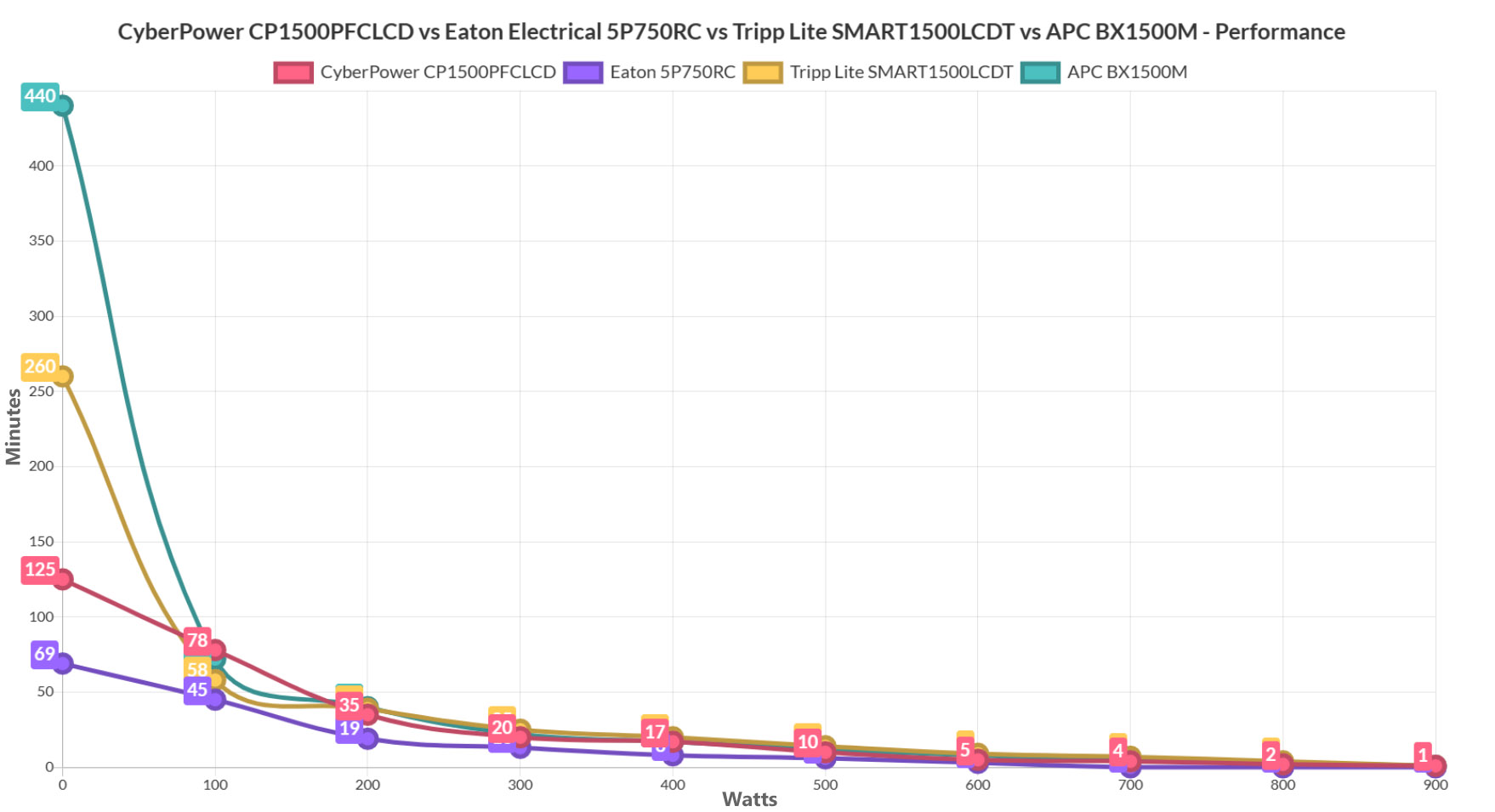
Important note: Before purchasing any uninterruptible power supply (UPS), you need to make sure that it can handle your devices. That’s why it’s important to verify the power consumption of your equipment prior of purchasing (it can be done by using any inexpensive electricity usage monitor, like the cheap Kill-A-Watt.
1. CyberPower CP1500PFCLCD Review
CyberPower Systems is a well-known USA-based manufacturer of uninterruptible power supplies, surge protectors and other backup power solutions, with some of its more popular products being the affordable line-interactive UPS devices. Some devices are known to not work well or to be completely incompatible with a simulated sine wave UPS (such as sensitive audio or medical units), but, recently, people have also experienced some problems with computer power supplies that require an active PFC power source compatibility.
Of course, there are some expensive uninterruptible power supplies that will do the trick but you don’t necessarily need to break the bank to keep your computer protected because the line-interactive CyberPower CP1500PFCLCD is able to offer the necessary protection. Additionally, you can have a look at the CP1350AVRLCD, a less expensive, but capable uninterruptible power supply that also features a simulated sine wave output and was suitable for a large array of electronic devices.
As expected, the CP1500PFCLCD is an elegant device, featuring a mini-tower case, with rounded corners and covered by a matte finish all around, except for the front and top, where there are some glossy pieces of plastic embedded inside the case (from the front, the glossy finish continues along the bottom side towards the rear of the UPS). On both the right and left side, there are two narrow horizontal vent grills and one vertical, which, along with the cooling fan should ensure that the unit remains cool under any circumstances (be careful not to obstruct the vent grills).
The cooling fan will turn on once the system uses the backup battery and, during the operation time, you will definitely be able to hear it (it’s not loud, but it is noticeable) and the noise should last until the battery is no longer needed. Since this is a better-designed device than its industrial-looking competitors, you’ll have no problem positioning it anywhere in the room (especially because of the front LCD display), but, be aware that the CP1500PFCLCD is not really a compact UPS, its dimensions being 14.2 x 3.9 x 10.4 inches (the same as the less powerful CP1350PFCLCD) and it is reasonably heavy (it weighs 24.7lbs).
The front side of the CyberPower CP1500PFCLCD is occupied by a LED-lit Power button (it illuminates when the UPS is working properly and the outlets are providing power, free of surges), an LCD which shows UPS information using icons and messages: the battery capacity, the load capacity/sensitivity set up, fault, overload, schedule, estimated runtime and output meter. Underneath the display, there are three buttons: the Display switch (press it to roll down the function menu and hold it for 2 seconds to turn on/off the display in Line Mode), the Silence Alarm switch (press it to roll up the function menu and hold it for 2 seconds to silence the battery buzzer) and the Control switch (press it for 3 seconds in Line Mode to start a self-test on the battery). Also on the front, there are two USB ports (5V 1A power output).
On the rear side you can find lots of ports and connections: at the top, there are two Communication Protection ports In and Out (which protects any network, telephone line, modem, fax or RJ11/RJ45 Ethernet connection), there are two Coax/Cable/DSS surge protection ports (In and Out) a bit on the left (suitable for cable modems, DSS receivers or CATV converters) and on the right, there is a USB port and a Serial port to PC, as well as a Wiring Fault Indicator (it will illuminate red if there is a problem with the electric circuit, such as bad ground).
Underneath these ports there are five battery and surge protected outlets on the left (which ensure temporary operation of your devices during a power outage – don’t connect laser printers, vacuum cleaners or other larger electrical devices) and five Full-Time Surge Protection Outlets. The first outlet of each array (the top ones) are designed for AC adapters, so it won’t be blocking any adjacent outlets. In the middle, there is a red button (Circuit Breaker), which serves the role to provide overload and fault protection.
Features and Performance
One of the most interesting features of the CP1500PFCLCD is its sine wave output, which provides power protection to modern computers and sensitive equipment (such as ENERGY STAR® 6.0 systems with Active PFC power supplies). Keep in mind that this type of UPS devices can be found at more expensive prices than the CP1500PFCLCD, but, at the same time work the best with most types of equipment (including sensitive hardware), without worrying about any possible damage. The CP1500PFCLCD also uses the GreenPower Bypass Design, which has the role to reduce the power consumption, by not using the transformer when the AC power is stable.
Additionally, the UPS has some built-in filters, like the electromagnetic interference filter (suppresses conducted interference on a power line), surge suppressors (which diverts the excess voltage from your electronic devices) and the AVR (Automatic Voltage Regulation), which has the role of automatically stabilize any power fluctuations (like increasing/lowering the voltage to proper levels), without using the battery power.
CyberPower offers a small utility (PowerPanel Personal Edition Software), which allows you to control and monitor the UPS. To use the utility you need to install it on a computer or server (from the official website) and connect it to your UPS device using the HID-compliant USB port or serial port. The interface shows the Power Source, the Battery Capacity and the Estimated Runtime and features three main tabs: Monitor (shows the current status and displays the last power event), Configure (here, you can configure the notifications alarms and sounds, the runtime, the tolerance to voltage fluctuations and you can conduct a self-test) and Help.
The CyberPower CP1500PFCLCD can handle a maximum of 1500VA or 900W and if you don’t need that much power, there’s also the 1350VA CP1350PFCLCD. Obviously, before getting one of these uninterruptible power supplies, it is advisable to know how much power is being drawn by you devices. The best way to find out is by getting yourself one of those small electricity usage monitors, which will show an accurate measurement of the power consumption.
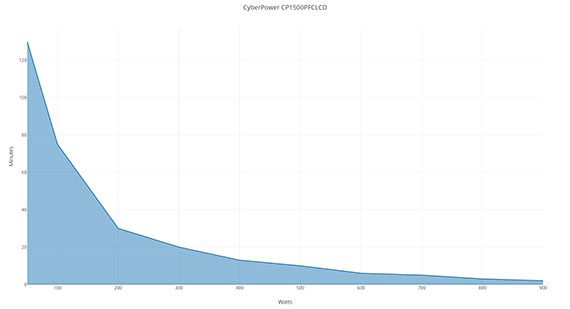
The CP1500PFCLCD is able to deliver an average of 120 minutes if your devices need around 50W of power, otherwise, at 100W, you will have about 70 minutes of power for your connected devices. If you need between 300 to 400W (a common consumption for a high-end computer), the UPS will keep your system alive for no more than 15 minutes. At full load, the CP1500PFCLCD will keep your devices powered on for about 2 minutes, which means that it’s ideal to configure automatic shutdown from the provided utility, so you won’t lose any files.
Note: The battery will recharge from 0 to full in about 8 hours.
2. Eaton 5P750RC Review
The Eaton 5P750RC is one of the more popular (and affordable) line-interactive rackmount uninterruptible power supply from the Ireland-based American company, being part of the 5P series which, along with Eaton 5SC1500 (that I already added to this list) are more suitable for rack servers, VoIP or network equipment, data storage or any other critical devices, than for home use (although, tech enthusiasts could definitely make use of it).
While APC and CyberPower are more focused on the consumer market, Eaton is a better known name in the enterprise world (especially in the electrical and industrial sector) and this usually translates into a higher price tag than you would find at some of its competitors. That being said, the Eaton 5P750RC is quite affordable and, considering that it has a reasonably clean sine wave output (so it will work with a large array of sensitive equipment), it’s worth having a look at what it can offer.
Design and Build Quality
While Eaton 5SC1000 was small and bulky, the manufacturer took a slightly different design approach with the 5P750RC by making the device a bit slimmer and taller so it can be easily accommodated inside a rack. Even so, you’ll get the usual metallic rectangular body, covered by a black matte finish and, on the front, there’s a grey piece with lots of tiny circular holes, next to a small display with three LED indicators and five buttons. As expected, nothing really takes away from the industrial vibe it emanates, but it’s fine, since the UPS was made to be put inside a server closet.
The Eaton 5P750RC shares the same dimensions as the better equipped 5P1000RC and 5P1500RC (which measure 14.6 x 17.3 x 3.4 inches), but it is the lighter of the bunch (at its 31.1 lbs). So, it is less compact than the desktop-oriented 5SC1500 and this may be an inconvenience after all, since it will take more space from the rack (it’s a 2U device). If you don’t want to mount it horizontally in the rack, the 5P750RC can also be positioned vertically (you get the necessary brackets in the package) and, if you want to keep it on or near a desk, Eaton has provided the means for the device to sit horizontally.
Note: Inside the package, there’s the Eaton 5P750RC UPS device, the rail and wall mounting kits, a USB cable, an RS232 cable, a Quick Start brochure, along with the Safety Instructions and Environmental documents.
I was unable to find any vent cut-outs all around the case, but that’s not really unusual for a rackmount UPS, since it will rely on the back-panel fan, which becomes active when the system uses the battery backup power. Eaton claims that the 5P750RC won’t go over 45dB, but, be aware that the device is a bit louder than the usual consumer UPS if left outside a cabinet or a server closet.
The small front-facing display has the role of showing the Operation status (which can be the Standby mode – if the device is turned off; Normal mode; AVR mode – which signifies that the utility voltage is outside normal mode limits; the On Battery mode – the Battery LED will be turned on and you’ll hear one beep every 10 seconds; End of backup time – when the battery is running low, you’ll hear one beep every 3 seconds), the Load/Equipment status, the Battery status and the Efficiency & Load Group info. Above the display, there are three LED indicators for Power, On battery and Alarm, while underneath, there are five buttons: Escape, Up, Down, Enter and On/Off, which are used to navigate the user settings and view the way the USP operates.
The rear panel is home to an attached input power cord for AC (6 feet long), a slot for communications card (sealed off – the card has to be purchased separately), an RS232 communication port, a USB port, a connector for RPO (Remote Power Off) or ROO control (the ROO functionality allows you to to control the UPS on/off state, but it can also be programmed to work as a remote signal input), the fan cut-out, a Ground bonding screw, the first group of four 5-15R outlets for connecting any critical equipment and lastly, two groups of four programmable 5-15R outlets for connecting your desired equipment.
Features and Performance
The circuit of the Eaton 5P750RC is pretty much similar to the 5SC1500: the input power (single phase, 100-125 V) is filtered and distributed to the AVR transformer (which has the role to regulate any fluctuating voltage to normal, constant levels – incredibly useful during brown-outs, so the UPS won’t immediately rely on the back-up battery) and, in case of a black-out, the circuit goes to the battery (through the charger, which, will replenish itself automatically when the power returns) and, lastly, to the inverter to give clean power to your devices.
Additionally, the entire 5P series of UPSes uses the ABM technology which, by using a three-stage charging technique, manages to significantly increase the battery life (by up to 50%) and it can also greatly reduce the recharging time.
Furthermore, the 5P750RC comes with the Intelligent Power Manager software, which provides its users with the means to monitor and manage the UPS remotely, while also giving the possibility of integration within a bigger network of more than one power devices (it will work seamlessly with both Microsoft’s SCVMM and VMware’s vCenter Server). To make use of the Intelligent Power Manager, you need to gain access to a computer and connect it to the UPS via either the RS232 or USB port (both communication ports can work simultaneously).
The software interface has a vertical left menu with four main sections: Views (features a list of all the nodes in the network, the Power Source and a detailed Node Map), Event Logs (Events List and Calendar), Management (allows its users to change the Nodes Settings, perform Nodes Upgrade and view the Configuration Policies) and Settings (Auto Discovery – automatically detects the devices from the network and performs a fast integration; Actions/Events – you can set certain notifications alarms or events to appear as a result of specific actions; Shutdown – you can set up prioritized or scheduled shutdown of your system; Infrastructure Connectors; Data Centre Management; System; Log; User List).
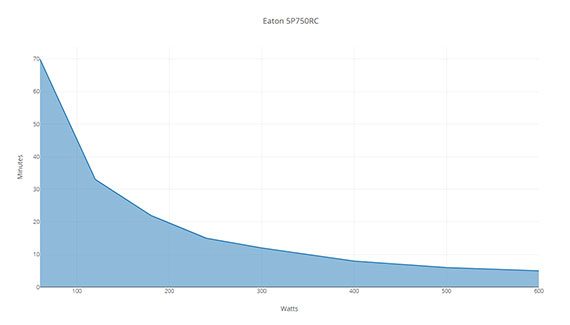
The Eaton 5P750RC can handle 750 VA or 600 W, so it may not be enough for a small to medium-sized office, not as a standalone unit, anyway (the series also features a 1000 VA and 1500 VA variant or you could just get more units). If you want to use it at home, the 5P750RC should be enough for a high-end computer, along with its monitor. So, if you connect devices won’t need more than 60 Watts, then you will easily be able to get more than an hour of battery life before the UPS will shut down. Otherwise, you’ll get about a half an hour if 120 Watts are being drawn, 8 minutes for 400 Watts and up to 5 minutes for the full 600 Watts.
3. Tripp Lite SMART1500LCDT Review
Tripp Lite is a small American company that specializes into the production of power protection and connectivity devices, including UPS systems, surge protectors, power strips, network switches, PDUs, cables, connectors, power inverters, rack cooling systems, power management software and laptop accessories.
Some of its more popular products are its line-interactive UPS battery backups, which covers between 550VA (300W) to 5000VA (or 3750W). I’m going to address the middle ground and focus on the Tripp Lite SMART1500LCDT, a 900W UPS, equipped with a front LCD display.
Design and Build Quality
The Tripp Lite SMART1500LCDT looks less elegant than the CyberPower CP1350AVRLCD or the APC BR1000G, but it seems to be a bit more compact. The case is rectangular, with straight edges (lacks any rounded corners) and it’s entirely covered by a black matte finish. The case has lots of airflow grills all around the case, from which four on the right and left side and two on the front side. Along with the thermally controlled cooling fan, the vent grills ensure that the case is properly cooled (make sure not to obstruct them).
The cooling fan kicks in when the unit gets too warm or when the UPS switches to backup mode and the noise it emanates is noticeable, but not insupportable. Like said before, the SMART1500LCDT is not the most attractive UPS on the market, but, because of the LCD display it offers a bit of aesthetic value, especially if you are going to position it on the desk. Although looking a bit more compact than the devices from the competition, the SMART1500LCDT is still a fairly large UPS, measuring 8.0 x 5.75 x 15.4 inches and it is reasonably heavy, weighing 27 lbs.
The front side of the SMART1500LCDT is home to a large square Power button and above it, there is a small LCD display with two round buttons, one for Test (press and hold the button to activate a self-test that lasts for about 10 seconds) and the other for Mute (can be used to mute an active alarm, by pressing and holding the button or to toggle the Power Conditions on the display). The small display shows info about the Output Voltage, Input/Output Frequency, Output Percent, Estimated Runtime, Battery Voltage and more.
On the back of the UPS, there is a fair amount of ports and connections: an upper USB Communication port (used to connect to a computer for unattended shutdown and for automatic saving of files in case of a power blackout) and underneath the large circular hole for the fan, there are two Tel/DSL/Network Line Protection jacks (which protect against surges over a single network or a phone line), two IN and OUT Coaxial Line Protection jacks (which protect the system against surges over coaxial line) and a Resettable Input Circuit Breaker button (which protects your electrical circuit from over current draw).
On the left and right sides, there are four Surge Suppression Only outlets (which offer premium surge suppression for accessories – don’t require the usage of the battery) and four Battery Backup outlets (offer surge suppression for critical devices, requiring battery backup support – these outlets will always remain active, even if the UPS is turned off).
Features and Performance
Besides providing a reliable backup battery, the Tripp Lite SMART1500LCDT features some interesting filters to better protect your equipment. First of all, you get Tel/DSL RJ11, AC Line and Ethernet surge suppression (handles up to 650 joules). Secondly, the UPS uses Automatic Voltage Regulation (AVR), which corrects and stabilizes any under-voltages (as low as 92V) or over-voltages (up to 150V), without relying on the battery backup power.
Furthermore, the SMART1500LCDT is equipped with an EMI/RFI Line Noise Filtering system, which removes any radio frequency or electromagnetic interferences. The UPS also uses the pulse-width modulation sine wave technology, so it may not work with voltage-sensitive devices (such as medical equipment), but it will handle almost everything else (most computers, switches).
Tripp Lite offers a free PowerAlert Software (tripplite.com/poweralert) which has to be installed on a computer or a network server, so it can communicate with the UPS through the USB cable connection. The utility looks neat (although a bit outdated), featuring five main tabs (Status, Actions, Settings, Logs and Help) and five secondary tabs (Device, Events, Contacts, System and Schemes).
Using the software, you can schedule actions (select an action from the menu and choose the time and frequency parameters), configure the Load Control (control the outlets individually: choose On, Off or Cycle), configure the Load Ramping (applied when the AC input power is turned on) and the Load Shedding (applied when the AC input power is lost), configure the Event, Email and SNMP settings, view Datalog, Syslog and Events Log.
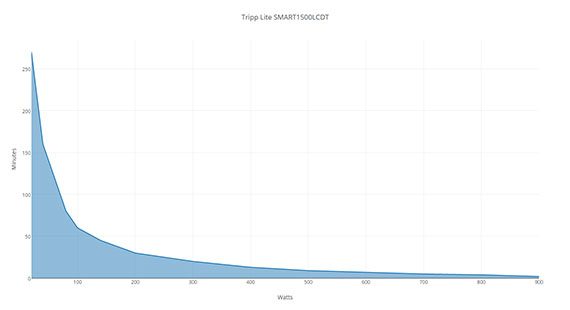
The Tripp Lite SMART1500LCDT can handle a maximum of 1500VA or 900W, which should ensure that lots of devices will continue to function after a power blackout. Before purchasing any UPS, you should be sure that your system doesn’t overload it, but it is also advisable not to be overkill. That’s why it is ideal to measure the power consumption by using a electricity usage monitor, so you get an accurate figure.
The SMART1500LCDT will be able to deliver up to 270 minutes if the power consumption is as low as 20W. If your devices need between 80 to 100W, the UPS will give you about 70 minutes of work time, otherwise, if your system uses between 300 and 400W (a mid-range to high-end computer), the UPS can ensure about 17 minutes, so you have the time to save everything and properly shut-down the devices. At full load (900W), the SMART1500LCDT will give no more than 2 minutes and it is better to use the provided software and configure an automatic shut-down (so you won’t lose any work done until that point).
4. APC BX1500M Back-UPS Pro Review
APC (American Power Conversion Corporation) is a widely known manufacturer of electronic peripherals, data centre products and uninterruptible power supplies (with simulated or clean sine wave output), focusing towards catering the needs of home users (in general, the consumer market) and on the development of the business networks.
Some of their most popular products are the uninterruptible power supplies from the Back-UPS Pro family, devices that provide protection from surges and spikes, as well as offering a management utility that allows for an easier maintenance and configuration (some UPSes also come with a small display for a convenient status output). The Back-UPS Pro series includes models between 850 to 1500VA, so I’m going to focus on the better-equipped unit, the APC Back-UPS Pro BX1500M.
Design and Build Quality
The APC BX1500M Back-UPS Pro looks surprisingly similar to the BR1500G, both devices featuring a mini-tower case with rounded edges, mainly covered by a matte finish. Furthermore, the BX1500M’s front side is divided into three sections separated by small canals, the middle part being covered by a black glossy finish (the APC logo is red to distinguish it from the BR series), the rest featuring a dark matte coating. The case also has some ventilation grills on the top area, as well as on both the right and left side, towards the bottom (underneath the carved-in APC logo).
These sections have the role to ensure a proper airflow and keep things cool enough (there is also a built-in fan that activates while on battery mode and when the battery is charging). The 1500VA APC UPSes have been known for their noisy fan, but the BX1500M’s fan seems to be reasonably quiet – be aware that some users have complained about some coil whine (APC claims that it was fixed with the newest batch). Since this is a modern-looking device (unlike the traditional, industrial UPS), you can leave it on the desk, but keep in mind that you’re not really dealing with a small device (it measures 9.8 x 3.9 x 15.0 inches – larger than the CyberPower CP1350AVRLCD) and it’s also quite heavy (it weighs 24.2 lbs). On the bottom of the UPS, as usual, you can find a label with printed info about the unit (this is also the place where you can remove the plastic cover and expose the batteries).
The front side of the case is home to three buttons (they’re positioned on the top edge): the first is Mute (allows you to enable or disable any audible alarms), Power On/Off and Display (press it to verify the status of the UPS and switch between the Full-Time and Power Saving mode), and there is a rectangular LCD display, which shows the status of more than 20 utility and battery backup conditions (which includes Load Capacity, Battery Charge, Overload (when the power demand exceeds the capacity), Event (the number of times that the UPS switched to on-battery mode), Automatic Voltage Regulation (if it’s enabled, then the UPS is compensating for low input voltage), Input/Output voltage, Error, Mute, Replace Battery and On Battery).
On the back of the device, there are lots of ports and connections: from the top left, there are two In/Out Ethernet surge-protected ports (connect a cable modem to the In port and a computer to the Out port), two coaxial surge-protected ports, one USB and Serial Data port (to use the PowerChute Personal Edition) and a Building Wiring Fault Indicator (if it’s illuminated, there is a wiring fault); on the middle, towards the left, there are four battery Backup outlets with surge protection. In the middle, there is a larger Circuit Breaker ‘Push to Reset’ button, which allows for a speedy recovery from overloads, while on the right side, there are four other Surge Protected outlets (these outlets offer full-time protection from surges, even if the UPS is turned off – suitable for printers and scanners, that don’t require battery backup protection).
Features and Performance
Before reaching for the back-up battery, the APC BX1500M uses some filters that protect your devices against brown-outs or over-voltages. The waveform type of the BX1500M is stepped approximation to sine wave (the second best thing after the online / double conversion UPS devices), so, it will emit a buzzing noise while functioning, but since the UPS has EMI and RFI noise filtering, it shouldn’t cause any kind of discomfort.
Furthermore, the AVR feature (Automatic Voltage Regulation) automatically corrects any voltage fluctuations, instantly adjusting any low or high voltages to proper levels, therefore stabilizing the AC output, so you can continue working through brownouts (the Boost and Trim feature). Additionally, the UPS has some ‘green’ features, like AVR Bypass or the power-saving outlets, which help reduce the power consumption (this mode bypasses any unused electrical components).
The APC BX1500M has a PowerChute Personal Edition Software (can be installed from the provided CD or by accessing the manufacturer web page – connect a cable from the UPS’ data port to a USB port from your computer to install the utility). The small management utility allows you to monitor your system (run self-tests, see the current status and the energy usage), configure the system (so it can prevent any data corruption and deliver a proper unattended OS shutdown, in case the power outage takes a prolonged period of time). The problem with the PowerChute software is that it hasn’t been updated since 2012 (!), so it seems that APC doesn’t really expect people to access the interface that often – it’s also not compatible with Apple devices.
The BX1500M can handle a maximum of 1500 VA or 900 Watts and, if you’re unsure of how much power does your system needs, you could use an electricity usage monitor (the Kill-A-Watt tool is extremely useful). If the BX1500M seems to fit the bill, also be aware that it’s ideal that you will leave a tolerance of about 20%, so, in case the maximum power consumption of your system is 400W, then a 600W UPS should be ideal (the Back-UPS Pro series also includes some less powerful variant as well, which includes the APC BX1350M or the BX1000M).
Now, getting to the testing part, the UPS should ensure about an hour and a half if your devices pull close to 80W. Furthermore, if your system is hungrier and consumes about 450 to 500W (common for higher-end computers), the UPS will deliver about 14 minutes. When close to the full load (900 W), the APC BX1500M Back-UPS Pro will keep your devices alive for about 1 to 2 minutes (enough to safely shut-down).
Note: The battery will need about 8 hours to fully recharge.
5. CyberPower PR1000RT2U Review
If you’re in the market for a new UPS, CyberPower is going to be one of the first brands that you’re going to check due to their solid offering of power management solutions especially for the consumer market (the PFC compatibility has made them the go-to manufacturer for a cleaner output, but at an affordable price). The UPS that caught my interest is the PR1000RT2U and unlike the OR1500PFCLCD or the CP1500PFCLCD, which are tower UPSes, this time, we’re dealing with a rack-mountable device, so it’s going to be less noisy (when the power goes down) and it should be easier to handle in regards to the space management. But, this is a device focused more towards the SMBs, so the price tag is unfortunately, a bit higher than let’s say a CP1500PFCLCD.
Still, similarly to the two aforementioned UPSes, the PR1000RT2U is also able to deliver a cleaner sine wave output, making it a lot more suitable for sensitive equipment (relies on the line-interactive technology). And yes, we’re still dealing with the line-interactive topology, the expected battery backup, as well as the surge protection.
Design and Build Quality
Since it went with a rack-friendly design (avoided the tower-like case), the CyberPower PR1000RT2U looks more like a switch or PDU, featuring a flat rectangular case with mounting holes on the right and left side, while the front is mostly occupied by multiple cut-outs. But on the right side, there is a small display where you can see the status of the UPS and control the way it’s going to function. The UPS relies on a single fan to keep the internal temperature in check (same as the PR750RT2U model) and, since it’s positioned on the rear side, it pushes out the air that comes from the frontal cut-outs. As expected, the fan gets activated as soon as the device is operating in battery mode, otherwise, it’s pretty much silent.
CyberPower claims that the fan is ultra quiet, which is not entirely true. Sure, it won’t wake you up in the middle of the night after a power outage (the beeping will!), but you can certainly hear it while it’s active. At the same time, since it’s going to sit in a rack, it shouldn’t really matter, especially considering that it’s going to most likely end up next to other noisy networking devices (such as PoE Ethernet switches which have rarely have quiet fans). The PR1000RT2U is not that compact (not that it needs to) and it’s dimensions are 17.1 x 3.4 x 16.2 inches – it’s also quite heavy due to the internal batteries, since it weighs 50.1 lbs.
The front of the PR1000RT2U can be removed without using any tools to reach the battery bays (they’re hot-swappable) and it’s worth mentioning that the LCD module can be rotated 90 degrees, as well as be tilted for a better viewing angle. Above the color display, there is a Power switch (press and hold it for about 2 seconds to either turn the device On or Off) and all the other buttons can be used to display a specific function on the small screen. Some of the main functions are the Sensitivity and this is very important because it will allow you to adjust how the UPS will interact with your devices, so, in case you are connected to a product that can handle a more unstable input voltage, then a Low Sensitivity will trigger the Battery Mode less often. Then, there’s the possibility to perform a Self Test, check the Input or Output info, the UPS Temperature, use the Outlet Control and more.
On the rear panel is where you’ll find all the outlets: on the top left, there are two blocks of four battery backed and surge protected outlets (don’t connect laser printers, vacuum cleaners, paper shredders, copiers or any other demanding device which may damage the UPS), and in-between them, there are two output circuit breakers, one for each block of outlets. Next, there’s the fan and then there’s a SNMP/HTTP network slot, followed by the Input Circuit Breaker (offers fault and overload protection). Underneath the slot, there’s a Wiring Fault Indicator (will illuminate in case of wiring problems, such as bad or missing ground and reverse wiring), a TVSS ground screw, and EPO/ROO port (useful in a large network, where you can easily power off all equipment), a USB port to PC (allows communication from the USB port of a computer to the UPS device), a USB port, a Serial port, a Dry contact port, some surge protected communication ports and an AC Input Power Cord connector.
Features and Performance
In terms of features, the CyberPower PR1000RT2U is somewhat similar to the CP1500PFCLCD, offering the same sine wave output with protection for Energy Star systems (with Active PFC PSUs), so you can connect your powerful computer or any other more sensitive devices (such as sound or medical equipment) without worrying about damaging them. Additionally, the UPS offers the GreenPower UPS Bypass Design, so, in case the AC power is stable enough, it will bypass the uninterruptible power supply’s transformer, therefore, reducing the energy consumption.
The circuit of the PR1000RT2U seems to show that the UPS immediately uses an EMI noise filter followed by a Surge Suppressor (2430J) and from here, it bifurcates into the Charger AC/DC to the Battery (so it charges the battery after a blackout) and to the AVR (Automatic Voltage Regulation) which has the role of increasing or lowering the voltage at the proper levels without requiring the battery power. In case of a blackout, the circuit will go through the battery and through an Inverter to reach your devices.
The PR1000RT2U comes with the PowerPanel Business Edition Software (downloadable for Windows OS, Linux OS or MacOS) that features a user-friendly interface and offers the possibility to monitor and control the UPS (includes remote control). The utility displays the status of the device on the left (includes the UPS Type, the Voltage Rating, the Power Rating, the Current Rating, the Frequency Rating, when to Replace the Battery, the Estimated Battery Module and more. On the right, there are five tabs on the top menu: Dashboard, the UPS Settings, the Setting, the Reporting and Help. One of the most common concerns that people have is whether the UPS will handle their system. Some may be tempted to assume that the PSU rating holds the answer, but it’s not completely true, because if you have a 1000W PSU, you won’t really reach that level of consumption, even on full load (well, with GPU manufacturers disregarding power consumption for more graphic power!!, we don’t really know whether we won’t have to upgrade our PSU really soon). But, to be absolutely certain that this is the perfect UPS for you, try testing your system by using an electricity usage monitor (like the cheap Kill-A-Watt – even a smart outlet will do the trick, such as the Gosund Smart Socket).
If your system pulls around 300W, the UPS will ensure no more than 40 minutes, so you can have enough time to shut down the PC correctly and not lose any unsaved data (you can also continue using your PC for a while – maybe the power gets back on by the time the UPS battery gets depleted). If you have more devices connected and it amounts to around 600W, then the USP will deliver around 14 minutes before shutting down. If your system requires 1000W (in which case I would recommend to look for something more powerful), the UPS will offer about four minutes before shutting down.
6. APC Smart-UPS SMT1500 Review
APC is an American company, well-known for its uninterruptible power supplies (UPS), covering both the consumer oriented side, with line-interactive UPS devices and the business marketplace, with the more expensive online / double conversion UPS devices.
I’ve already had a look at one of the more affordable solution from APC, the BR1000G Back-UPS Pro, which is a capable unit, powerful enough to handle up to 1000 VA or 600 Watts power consumption and it offers a front LCD for the status of the system. Surely, most of the people won’t need anything more, but, there are some devices might not won’t work well with cheaper simulated sine wave output uninterruptible power supplies (such as active PFC (power factor corrected) servers and sensitive electronics), so you may be forced to have a look at some more expensive UPS devices but with a better sinewave output. One of these devices is the APC Smart-UPS SMT1500.
Design and Build Quality
While the APC BR1000G Back-UPS Pro was a slim, elegant device, the SMT1500 is the complete opposite. You get a wide, but fairly compact rectangular case, covered by a black matte finish and, on the front, it has lots of recessed and protruded sections, with the LCD display embedded on the upper front side, surrounded by curved plastic bezels and underneath, there is a big white APC logo. I was a bit surprised to see that the case only has two rectangular patterns of vent holes (one on the left and one on the right), but, the unit remains cool enough while functioning and there is a built-in fan which should ensure a proper cooling.
During normal operation, the unit remains silent and the cooling fan switches on when the UPS runs on battery mode, when the case is too hot and while it recharges the battery (during this time, you will be able to hear the fan noise). Overall, the UPS doesn’t really provide a lot of aesthetic value, but it will sit nicely on the table since it looks like a mini-tower desktop computer and the LCD enhances a bit the appearance. Keep in mind that the case is really large (it measures 8.6 x 6.7 x 17.2) and very heavy (it weighs 53.0lbs – almost double than the other UPS devices from this list).
On the front side of the SMT1500, inside the embedded glossy panel, there is a long On/Off button and underneath it, there are four LEDs responsible for Online, On Battery, Fault and Replace Battery. Under the LEDs, there is an LCD display which shows the detailed information about your system and gives you access to an advanced or basic menu (Input/Output voltage and frequency, battery capacity and runtime, load energy meter, alarm, delay and threshold settings and more). Further down, there are two Up/Down arrow keys, an Escape button (exists to previous menu or screen) and an Enter key (confirm settings).
The rear side of the APC Smart-UPS SMT1500 is full of ports and connections: on the upper side, there is a USB port (used for connecting to a computer, in order to use the power management software), a RJ45 connector (serial UPS monitoring port – also used to gain access to the power management software) and underneath them, there is a large SmartSlot for optional NMC accessory card. On the right side, there is an Internal/External battery connector and a Circuit/breaker/Overload protection button.
In the centre, there are eight 5-15R Output connections (NEMA) outlets (from which, four are part of the Switched outlet group – ‘Group 1’ – meaning that the UPS manages the power to them independently: turn on, restart or shut them down independently of each other) and on the left, there is a chassis ground screw (to connect it to the ground leads on transient voltage devices).
It is true that the outlet placement is a bit odd and you can’t plug AC adapters (usually, other UPS devices have a couple of separate outlets specifically for this purpose) and, in order to correct this problem you can use power extensions cord.
Note: On the top of the UPS, there is a large label, which contains Installation and Setup Tips.
Features and Performance
The APC Smart-UPS SMT1500 provides a better-than average sine wave output while using the battery (for a line-interactive UPS), ensuring the maximum degree of compatibility with most electronic device, but, considering the high price, it’s recommended for power factor corrected (PFC) power supplies and other type of sensitive electronic equipment, such as audio devices (you will notice that there won’t be a buzzing sound like you get with the usual simulated sine wave UPS).
Additionally, the SMT1500 maintains an efficient power consumption by conserving the energy when the power quality is optimal, without sacrificing any protection. Furthermore, the UPS provides surge protection, noise filtering and the Automatic Voltage Regulation feature (AVR), which has the role to adjust any low or high voltages to a stable level, so your battery can last a lot longer.
The APC SMT1500 uses the PowerChute Business Edition Software which can either be downloaded from the official website or by using the provided CD (you need to connect the UPS to a computer using the USB port or the serial UPS monitoring port). What’s interesting is that Windows 7 (and later) users don’t need to use the PowerChute software to shutdown their computers because the UPS allows the OS to read the battery level and safely trigger the shut-down. Obviously the PowerChute utility offers a larger array of options.
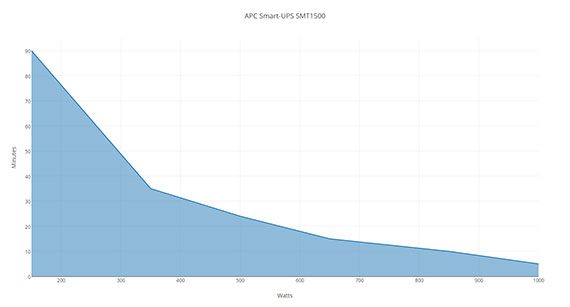
The software features three options: PowerChute Business Edition Agent (which provides status monitoring of your UPS and delivers system shutdown capabilities in the event of a power outage), Business Edition Server (provides centralized event tracking from all the UPS Agents) and PowerChute Business Edition Console (used to configure and monitor your Agents). The utility shows all the Agents (UPS devices connected) and it features the following options on the left: Status, Power Event Analysis, Voltage Analysis and Risk Assessment.
The SMT1500 is able to handle 1500 VA or 1000W which is a lot for most of the people, but suitable for small businesses (since this is a relatively costly solution, you can also have a look at the less expensive APC-Smart UPC SMT750 or SMT1000). Before purchasing any UPS unit, you should know the power consumption of your devices and to get an accurate reading, you could use an electricity usage monitor (like the cheap Kill-A-Watt).
Now, getting to the testing part, the APC Smart-UPS SMT1500 will deliver up to an hour and a half of power juice, if your devices use an average of 150W. If you need between 300 and 400W (common for high-end computers), then the UPS will keep your system alive for around 30 minutes, so you have enough time to save all your files and perform a safe shut-down. Under a heavier load (between 850 and 1000W), the UPS will give you about 5 minutes before shutting down.
HERE!
7. Eaton Ellipse Pro UPS (1200VA) Review
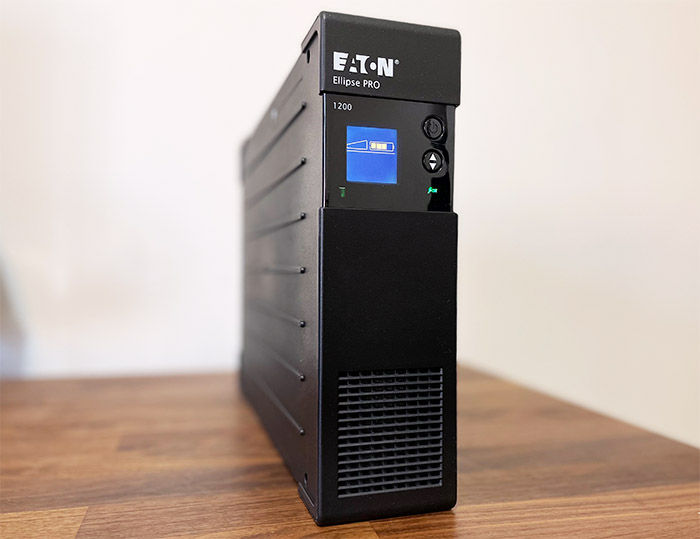
The Eaton Ellipse Pro series differs quite a bit from the 5SC and the 5P series, but not in regards to the used technology or performance, it’s mostly about the availability. The targeted audience seems to be outside the US, but I have seen that there are two version, the IEC and the DIN. The former does have C13 receptacles, while the latter uses EU-suitable outlets (Schuko). The series seems to be in the price range of the CyberPower CP1500PFCLCD, but it doesn’t boast about the ‘pure’ sine wave reproduction. Obviously, it doesn’t mean that the Eaton Ellipse Pro offers an unsuitable approximation, quite the contrary because the sensible power supply in my PC (PFC) didn’t complain about the power input.
Still, be aware that the simulated sine wave is not going to be that suitable for sensitive electronic equipment (which can be either audio or medical devices). But, considering the max output of 1,200VA which roughly translates to 750W, it means that the Eaton Ellipse Pro model which I tested is suitable mostly for home use, especially for PCs and network-related applications, as you can see from the full review. For this reason, I think that it does deserve a place in this article.
Design and Build Quality
The Eaton Ellipse Pro 1200VA is a tower-type UPS, but it can also rest on its side, just be aware not to put heavy objects above it. Also, don’t cover the intake or outlet areas.
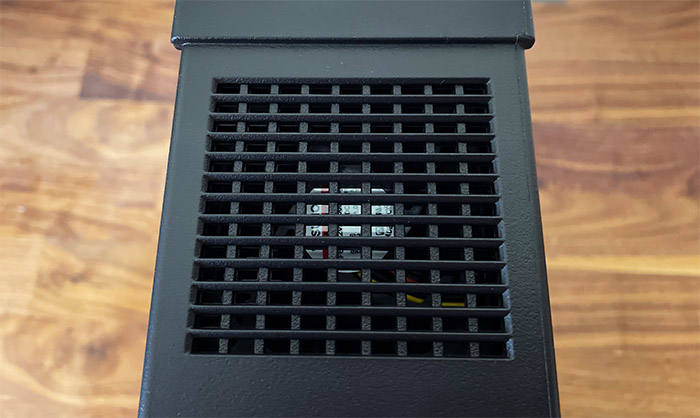
The device uses a built-in fan to cool down the case, but the fact that it is always running, it has annoyed some users. I didn’t really mind the buzzing, but I can see how it can be perceived as loud, especially during the night. The case is made of plastic and it’s covered by a black matte finish, while on the front, there are some buttons along with a small display.
The display will show some useful info which includes the current output power, the percentage that’s in use from the overall budget, the VA, the voltage and the Hz. But, I really disliked the build quality of the buttons. When I pressed on one button, the other will sink into the case as well and that’s just unacceptable in this price range.
That being said, keep in mind that this type of UPS devices aren’t small, so, the Eaton Ellipse Pro measures 15.3 x 10.8 x 3.2 inches and it is also a bit more heavy, weighing 22 lbs. Since it’s so narrow, the manufacturer had to position the receptacles on the rear side and at the top, but don’t worry, the UPS will not flip over because the batteries are positioned at the bottom of the device. The top four receptacles consist of two EcoControl outlets that disable any peripherals from a main device that has been shut down.
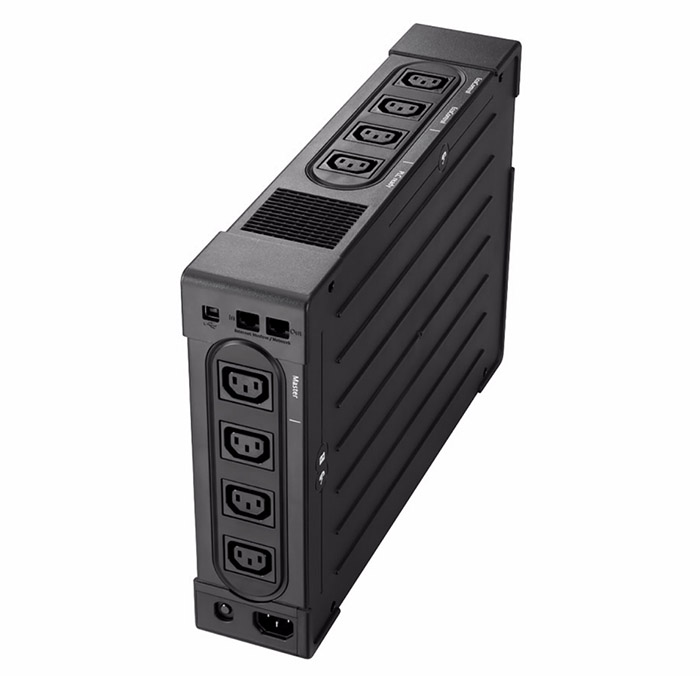
And there is also a PLC outlet that allows the powerline signal to safely pass through without adding any interference. On the rear side of the Eaton Ellipse Pro 1200VA, there are other four outlets, the first being the Main, but you can also see a Console port at the top, as well as two Ethernet ports. These ports can be used to protect a LAN connection or the modem connection from surges, but be aware that they’re limited to 100Mbps, which is a bit of a shame considering the wide spread of the Gigabit connections.
Beneath the four C13 outlets, there is the power port along with the Circuit Breaker button. I do need to mention that Eaton does allow you to change the batteries (which the manufacturer claims should last for about 4 years). And to do so, you need to remove the two screws from the bottom of the case, then detach the plastic piece that goes up to the aforementioned Power port.
After that, you should see a connector that needs to be detached, followed by the easy removal of the two batteries.
Features and Performance
The circuit of the Eaton Ellipse Pro seems to be designed like this: first, there’s the Filter, afterwards, there is the AVR transformer and, if there is no power blackout, it skips the battery backup. Otherwise, the battery can either use the charger so it goes to 100% or the inverter in order to power up your devices.
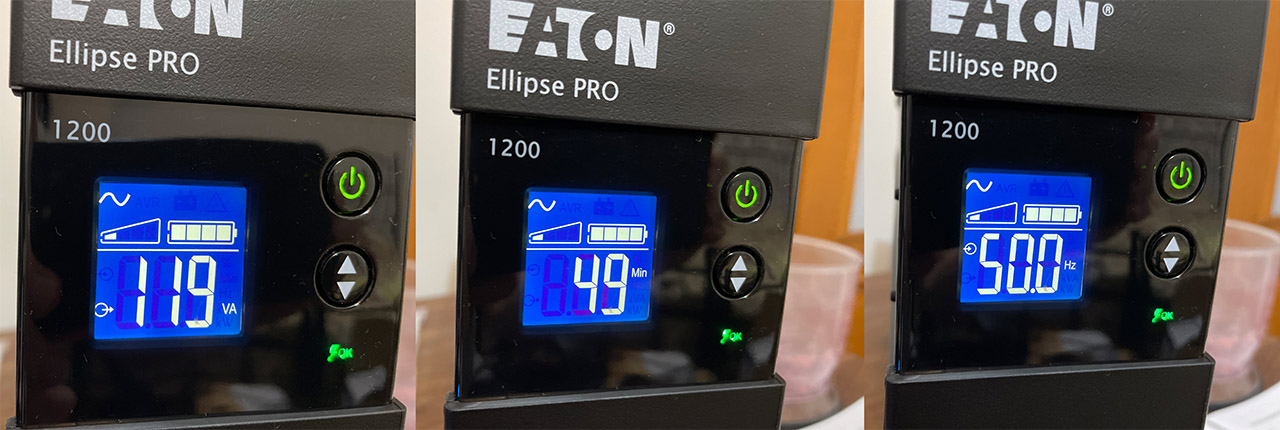
The filter includes data line surge protection and the Buck and Boost operation which corrects a large range of input voltage variations (the boost part increases the low input voltage and the buck part decreases any high voltage input), without relying on the battery backup power (a great feature when you experience frequent brownouts). Additionally, the Eaton ABM battery management technology increased the battery life up to 50% by using a three-stage charging system (charge mode, rest mode and test mode).
But, the most important feature of the Eaton Ellipse Pro should be its ability to offer a clean sine wave output and, as I mentioned before, it’s better than other UPS on the market, but still behind the double-conversion uninterruptible power supplies. That being said, you can connect a computer to the Eaton Ellipse Pro and use the Eaton UPS companion software (compatible only with Windows OS, because why not), which allows you to customize some of the UPS settings.
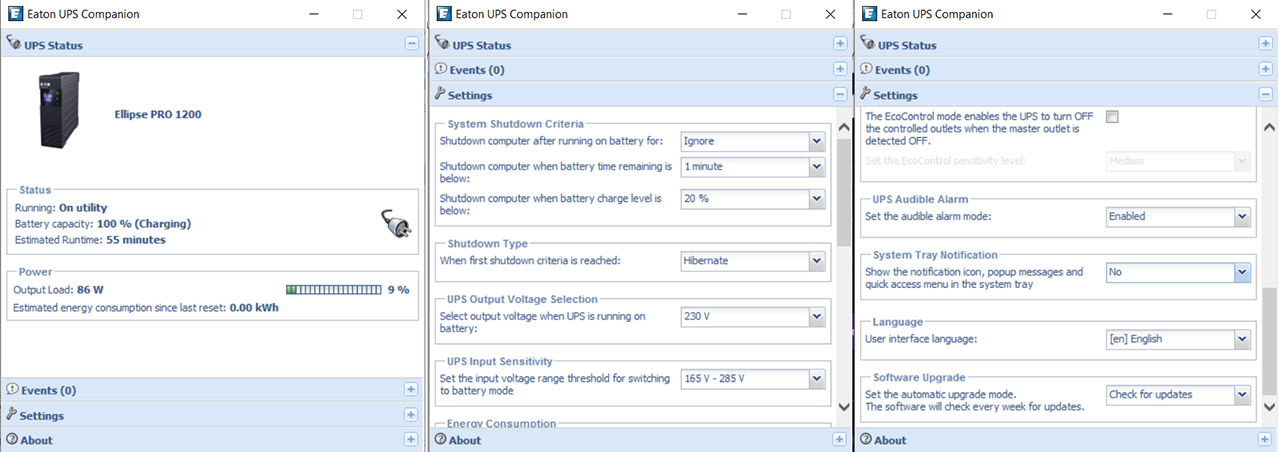
The utility interface is not very modern looking, but it does show some status information, similar to what you can see when checking the data from the display, but there is also a Settings section. Here, you should be able to set what happens with a computer after a blackout, enable the Audible Alarm, update the firmware, check the Energy Consumption and more. The Eaton Ellipse Pro model that I tested can handle 1200 VA or 750 Watts, which is more than enough for most people and, why not, even for some small businesses.
Surely, since this UPS will cost a bit more than the common UPSs, it is important to know exactly how much power will your devices need – you can easily find out by using a cheap electricity usage monitor. From my tests, it seems that the Eaton Ellipse Pro is able to deliver about an hour if the power consumption of your devices is as low as 100W, otherwise, if your system needs about 300W, you get about 12 minutes.

If your devices need between 600 and 700W (the usual power consumption of a high-end computer), you get about 1-2 minutes, so you can save all your files and perform a safe shut-down. At full load (750W), the UPS will give you about (or even less than) a minute of runtime (so it’s ideal to setup an automatic shutdown if your devices need a lot of power).
Note: The series also includes less costly UPS devices like the Eaton Ellipse Pro 650VA, as well as a costlier model, the Pro 1,600VA.
8. Liebert GXT4-1000RT120 Review
The Liebert products are part of a very long history of technological development which had a deep impact into the shaping of the tech industry (some of these products can be traced back to the beginning of the informational era). While before the Liebert brand was owned by the aforementioned longevous manufacturer, the Emerson Network Power, it is now under the new Vertiv company.
The Liebert products include power distribution devices, power transfer switches, room and rack cooling and uninterruptible power supplies. But, to maintain the theme of this article, I am going to focus on one of the most popular UPS from Liebert, the GXT4-1000RT120, an online double conversion device which should ensure a proper protection of your equipment from any type of power disturbances (likes surges, blackouts, brownouts or noise interferences). Liebert devices are generally suited for more sensitive industry equipment (therefore, more compatible with medium to larger businesses than with the home equipment – the price is a hint).
Design and Build Quality
Similarly to other enterprise-grade devices, the GXT4-1000RT120 won’t satisfy your aesthetic cravings because Liebert aimed to make the device as ergonomic and functional as possible, so the UPS would feel more at home on a rack and less on your living-room coffee table. The rectangular case of the GXT4-1000RT120 is fairly compact, covered by a black matte finish and on the front, there are lots of ventilation slots which have the role to ensure that the device remains cool. Just like the Eaton Electrical 5SC1000, there aren’t many vent holes all around the case and it also has a built-in fan to help maintain a proper temperature.
Now, I said before (in the small intro) that the GXT4-1000RT120 isn’t really suited for home use (or even for some small offices) and one of the reasons is because the device is very noisy. It’s true that the fan is built to automatically change the rotation speed depending on your system requirements, which should maintain lower noise levels, but regardless of that, the UPS remains noisier than your average home UPSs and it is more suited to be installed in a rack for commercial data center equipment, where you won’t be bothered by the noise (after all, it is a bit overkill for home devices).
Liebert allows you to position the GXT4-1000RT120 in more than one way: you can install it as a tower by using the two support bases and the necessary spacers (included in the package – if you also want to use additional battery cabinets, don’t forget to add new spacers) and, because the UPS will now stay vertical, you need to remove the front plastic cover and rotate the small display 90 degrees (do the same for the logo). The GXT4-1000RT120 can also be mounted in a rack (in the package you can find all the required hardware to install the device on a rack), but be aware that the UPS unit is heavy (40 lbs) and it measures 16.9 x 16.2 x 3.4 inches (also, the operating temperature is between 32-104 degrees F).
On the front of the UPS unit, in-between the airflow vents there’s a small LCD display and around it there are four round buttons (ESC, UP, DOWN and ENTER, all used to operate the display) and some LED indicators for Fault (lights up when there’s an error within the UPS), Inverter, Battery (active while the load is supplied by the battery), Bypass (active while the load is supplied by the mains through manual/automatic bypass), Programmable Outlet 1, Programmable Outlet 2 and ECO Mode. The default screen of the LCD display shows the Input/Output, the Battery capacity and the Load. The Main Menu screen allows you to view the Status of the UPS, access the Configuration sub-menu (UPS, Battery, ECO Mode, Outlet 1&2, LCD and Factory Default), access the Control screen (Turn On/Off the UPS, turn On/Off the Audible Alarm and view the Battery Test Result), view the Log and About screen and access the Network section.
On the rear side of the GXT4-1000RT120 there are lots of ports and connectors: from the left, there’s the Liebert IntelliSlot zone (to install the optional Liebert IntelliSlot Card), a USB Interface port (Type B), Terminal Block Communication (from top, Any Mode & Shut Down, Battery Mode & Shut Down, Battery Mode and Low Battery), an RS232 port (I know it may seem deprecated, but there still is (surprisingly) a demand for this type of connection to be used with industrial automation equipment), the cooling fan, an external Battery Connector (useful to connect to any additional battery cabinet), the Strain Relief Attachment, two 5-15R General Output Receptacles, four 5-15R Programmable Output Receptacles, an Input Circuit Breaker and the Input Power cable.
Note:The UPS comes with the battery already connected (the battery is hot swappable, so it can be replaced while the UPS is running).
Features and Performance
The Liebert GXT4-1000RT120 is an online / double conversion UPS (with a clean, near-ideal sine wave output), therefore perfectly designed to work with sensitive equipment (such as medical/industrial devices), but will definitely also work with computers that come equipped with Active PFC power supplies (although a cheaper line-interactive will work as well). The GXT4-1000RT120 is more than the usual uninterruptible power supply, as it functions continuously and instead of switching to the AP battery supply when there’s a blackout, the device always remains active (therefore constantly regenerating and controlling the AC). This makes it a lot better for the more sensitive devices. The circuit of the GXT4-1000RT120 is designed like this: first, there’s a Transient Voltage Surge Suppression and EMI/EFI input filters (which have the role of protecting the connected devices from any power surge and minimize any EMI or RFI present in the utility power), then the circuit can go directly to the Dynamic Bypass in case of UPS malfunction (overload, high temperature), to the Battery Charger (the batteries keep on charging whenever the UPS is plugged in) and to the Rectifier/PFC, which has the role to convert the received AC to regulated DC power (the rectifier ensures the near-ideal wave shape).
Next, comes the Inverter which has the role to create the precise sine wave AC power (it can receive the AC either directly from the PFC or, if the power fails, from the DC-to-DC Converter which is connected to the Battery). From the Inverter, the AC power goes through the last set of filters (EMI/EFI Output) and reaches the six outlets.
The package comes with a CD that contains the GXT4 Configuration Program. In order to customize the features of the UPS, first, connect a USB cable to the GXT4-1000RT120′ USB port and to a computer. Next, either run the program from the provided CD or download it from the manufacturer website. The small utility allows you to configure the UPS, the Battery, the Outlet 1, Outlet 2, ECO Mode and Dry Contact.
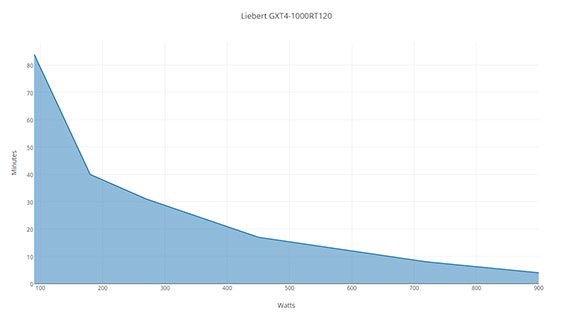
The GXT4-1000RT120 can handle 1000 VA or 900 Watts which should be enough for a lot of connected devices (but, as I said with every reviewed UPS, before purchasing, make sure it can handle the amount of devices and the total power load – this can be easily verified by using any cheap electricity usage monitor).
If your connected devices use 10 percent of the total capacity of the USP (90W), you get about an hour and a half to close any software applications and perform a safe shut-down. Otherwise, at 50% load (450 W), you get about 20 minutes and at almost full load (between 850 to 900 W), the battery gives you about 6 minutes before shut-down. After a full discharge with 100 % load, it will take about 5 hours to recharge the UPS to 90 %.
Note: If the 1000VA UPS is not enough, the GTX4 series also includes 1500, 2000 and even 3000VA UPSs.
STANDBY, LINE-INTERACTIVE OR ONLINE/DOUBLE CONVERSION TECHNOLOGY?
The standby UPS is the simplest from the bunch, as it only provides some surge protection and a simple battery backup. The way it functions is that it has the filtered AC power input as the primary source (connected directly to the power source) and in case it fails (in case the voltage goes under or above the normal levels), the UPS automatically switches to the battery-powered DC-AC inverter. Some people don’t even consider this type of devices as UPS (especially since it won’t offer any protection against brownouts), but standby power supplies (SPS).
The line-interactive technology is used by the most spread type of uninterruptible power supplies, which are suitable for small businesses, but also for more demanding household devices.
The way a line-interactive UPS works is very similar to the standby UPS, but the main difference is that it provides the buck/boost feature (which has the role to regulate the voltage). To be able to do this, the ups connects to a multi-tap transformer so it can adjust the output voltages (it boosts the output voltages in case of brownouts and it bucks the output voltages when the voltage rises above the normal level). Depending on the budget, UPS devices can have one or more taps so it can better adjust the output voltages. Of course, as the UPS is operating, the battery will recharge and when the power fails, the power flows from the battery towards the UPS output.
Lastly, the double-conversion design is the most common for UPS devices above 10kVA (but it’s also available for consumer-type usage). This type of UPS has the batteries always connected to the inverter, so it has zero transfer time (the in-line makes that chirp sound when it changes the transformer tap). An online UPS uses an AC to DC rectifier (which carries the load) and an inverter which run continuously until a black-out occurs, when the batteries simply continue to power up the devices. When the power returns, the inverter retakes the load, so not switch happens, thus making it ideal for sensitive equipment.
FEATURES TO LOOK FOR BEFORE CHOOSING THE BEST UPS
Besides the pure vs simulated sine wave output deal, you have to keep an eye for other important features that may prove to be a life saver in the future.
1. Pure sinewave vs simulated sinewave
If you’re looking to purchase a new UPS, you may have noticed that there are two main types of waveforms: a pure sine wave and a simulated (quasi) stepped rectangular sine wave. In reality there are actually three types, the last being a square sine wave output. The cheapest type of UPS uses the square sine wave output and as you may expect, it produces a square looking wave, while the pure sine wave is a lot more curved (if you remember from the math class) and obviously, the pure and simulated wave output are the closest to how the AC current wave should look like. Depending on the sensitivity of the equipment, you may hear a loud humming noise while using a square sine wave UPS or it may actually cause damage to your electronics.
The more commonly used uninterruptible power supplies are those that have a simulated sine wave output. These type of UPSes will work with almost every electronic device and do a great job protecting computers, servers, switches and so on. Also, these are middle priced between the three types of UPSs and are a lot cheaper than the pure sine wave output UPS devices.
Some time ago everything was good and everyone was happy with their simulated sine-wave UPS devices, but, at a certain point, PSU manufacturers started to incorporate what is called the active PFC technology. This is a great feature as it gives you a better voltage regulation and a higher efficiency, but there is a problem: it seems that it doesn’t really work well with cheaper simulated sine wave output UPS devices.
Therefore, some computers that have Active PFC power supplies may emit a buzzing sound while functioning and others may refuse to work at all (the UPS will power cycle), so you may be constrained to purchase a more expensive simulated sine-wave UPS or simply go for a pure sine-wave UPS (if you have the budget).
The pure sine wave UPS devices are more suitable for businesses that usually have computers running 24/7 and have sensitive equipment that has to be protected. And this is clearer from the price point of view, because a simulated sine wave UPS will cost two or three times cheaper than the pure sine wave counterpart.
2. UPS capacity
Obviously, the higher the number, the better. So, you have the time to safely shut down your devices and save any work you have done prior to the blackout. Choosing the UPS with the adequate power is not as hard as you may thing. First of all, use a cheap an electricity usage monitor to find out how much juice your devices use during max load and choose the UPS with a slightly higher number than the maximum needed power (for example, if you computer uses 350W, a 500 – 600W UPS should be enough – the higher the number, the more time you get to either continue your work or safely shut down your devices).
3. How much time before the battery needs to be replaced?
The lifespan of a UPS device varies based on different conditions. By default, a normal battery should deliver about 5 years of use before needing to be replaced, but if the UPS is kept at a good temperature and isn’t discharged frequently, you could very well get 6 or more years. At the same time, bad conditions could destroy the battery lifespan to a matter of days or hours.
4. The number of outlets and ports
This one is quite simple: the more outlets you have the better, because you get to connect a lot more devices. You will notice that as the power capacity and prices rise, there will be more outlets available and a more diverse type of ports.
5. Does it have an LCD display?
This feature is not really a vital one, but it is nice to have a small LCD display which shows you real-time data and the status of your UPS, the battery capacity, the estimated runtime and more (you can also do some basic configuration, without relying on the computer utility).

Mark is a graduate in Computer Science, having gathered valuable experience over the years working in IT as a programmer. Mark is also the main tech writer for MBReviews.com, covering not only his passion, the networking devices, but also other cool electronic gadgets that you may find useful for your every day life.

